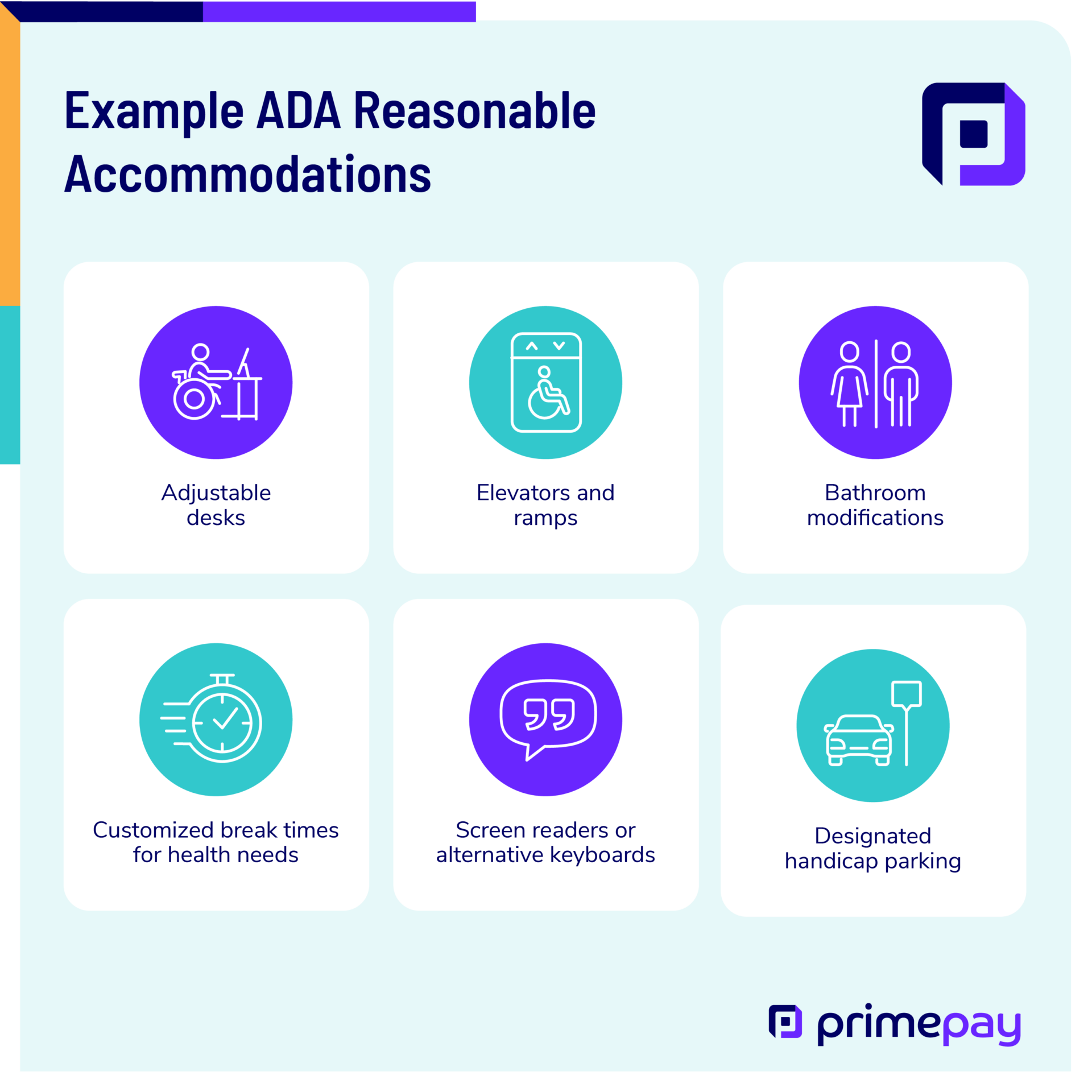Imagine you’re a wheelchair-using activist who’s accepting an award for your work, but you’re unable to collect it onstage because there isn’t a ramp. It may be horrifying to consider, but that’s exactly what happened to Anna Landre.
And while this specific story made news, many inaccessibility issues happen daily worldwide. You’ve most likely heard of the American with Disabilities Act (ADA), which protects people with disabilities from discrimination. As an employer, knowing about reasonable accommodations is imperative to maintain compliance and create an inclusive workplace.
Understanding Reasonable Accommodations
Reasonable accommodations are workplace adjustments that enable employees with disabilities to perform their roles. These accommodations involve practical changes to jobs or work environments that allow qualified individuals to:
- participate fully in the job application process
- perform the essential functions of their jobs
- enjoy the benefits and privileges of employment equitably
The ADA mandates that employers offer such accommodations, except when doing so would result in undue hardship – a term associated with significant difficulty or expense.
What is Undue Hardship?
Undue hardship refers to significant difficulty or expense incurred by an employer when providing accommodations for employees with disabilities. The aim is to balance the employee’s needs with the employer’s capacity to provide support without experiencing substantial disruption or financial strain.
The determination involves evaluating factors such as the:
- Overall financial resources of the facility
- Number of employees
- Effect on expenses and resources
- Impact on the facility’s operation
- Availability of potential funding sources, such as tax credits or external grants, to alleviate the burden
Because 58% of accommodations cost nothing, while the remaining typically cost only $500, undue hardship is carefully scrutinized to ensure that denying a reasonable accommodation request is genuinely justified and not a pretext for avoiding compliance.
Types of Reasonable Accommodations
There are many types of accommodations to help the differently-abled community, and they typically fall into three categories: physical modifications, modified work schedules, and technology and tools.
- Physical modifications: This accommodation is all about accessibility, with the added benefit of creating an inclusive and comfortable workspace. For example, interventions like adjustable desks or dedicated parking can be game-changers if someone is on crutches. But remember to think beyond disability short-term accommodations. Consider the needs of employees with canes, wheelchairs, or other physical ailments that may require long-term accommodations.
- Modified work schedules: Work schedule adjustments help those with chronic health problems. For example, individuals managing diabetes may find flexible scheduling instrumental in monitoring their blood sugar levels. Just ensure you keep individual-based scheduling decisions confidential so as not to violate HIPAA.
- Technology and tools: Assistive devices and software – like screen readers, alternative keyboards, or tools for those with hearing problems – can make all the difference for employees facing physical or sensory challenges. This kind of technology supports independence and fosters seamless team communication and collaboration.

The Process of Requesting Accommodations
The ADA interactive process of requesting accommodations begins when an employee or applicant voices their needs, typically in an informal manner. This dialogue, which can occur anytime during the employment lifecycle, is the first stride toward tailored support.
“While not mandatory, documentation is key to maintaining structured procedures,” says Melissa Adamo, a seasoned HR and talent acquisition leader. Employees should craft a formal written request—including a documented need for modifications—to create a valuable paper trail to ensure clarity and accountability.
Adamo also warns that “as more people return to the office, they want to emulate how they worked at home. Unfortunately, companies sometimes lump individuals with disabilities in this group instead of seeing their requests as true needs.”
So how do you distinguish between a reasonable accommodation and a nice-to-have?
“It all comes down to necessity versus comfort,” she explains. “And that decision can get gray if employers aren’t doing their due diligence of determining if requests are for documented disabilities or simply ‘comfy’ modifications.”
Once you receive an accommodation request and determine its validity, you’ll want to explore accommodation options (if the employee has not provided them).
After you choose the accommodation:
- Document the choice and when its use begins
- Have the accommodation installed (if necessary)
- Train the employee how to use it (if necessary)
- Routinely check in to ensure it’s meeting the employee’s needs
Can a Reasonable Accommodation Request Be Denied?
Employers, while generally supportive, may find themselves in a position where a requested accommodation is deemed ‘unreasonable’ due to its potential to impose undue hardship on the business. Such difficulties might stem from extensive costs, significant disruptions, or fundamental changes to business operations.
However, employers should actively seek alternative accommodations and contemplate external funding sources or tax credits to circumvent outright denial of a request.
Common Employer Mistakes
Despite good intentions, employers often make mistakes regarding reasonable accommodations.
These mistakes include:
- Not asking for medical documentation
- Delayed dialogue and/or follow-through
- Rejecting requests before doing due diligence
- Misinterpreting an employee’s medical status
- Not reevaluating policies and practices
- Failing to engage in the ADA interactive process
Creating a Compliant and Inclusive Workplace
As Adamo reminds People leaders, “If you’re going to say that your company doesn’t have an issue hiring those that need accommodations, you need to walk the walk.” Make sure you have procedures (and experts) in place to help your organization navigate employee requests to maintain compliance.
Lastly, remember that providing accommodations is not just a legal requirement. It’s also a powerful statement of your organization’s values. Hiring differently-abled people reflects that your company prioritizes building a diverse, caring, and inclusive culture – which ultimately leads to a positive employee experience and helps retain your people.
Reasonable Accommodation FAQs
What are reasonable accommodations?
Reasonable accommodations enable individuals with disabilities to participate in the job application process, perform their jobs, and enjoy employment benefits on par with their peers without disabilities. These modifications or adjustments to a job or work environment are essential for ensuring equal opportunities for people with disabilities.
Is an employer obligated to grant every accommodation request?
No, an employer is not obligated to grant every accommodation request. They can deny a request if it causes undue hardship or fundamentally alters the nature of the business.
Can flexible work schedules be considered a reasonable accommodation?
Yes, flexible work schedules are a reasonable accommodation. They allow employees with disabilities to manage their health and medical appointments without compromising their work responsibilities.
How do assistive technologies help employees with disabilities?
Assistive technologies, like screen readers and alternative keyboards, allow employees with disabilities to work independently and communicate effectively with colleagues, ultimately helping them perform tasks efficiently.


